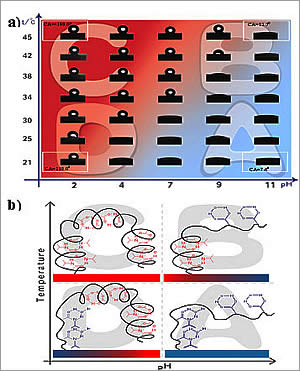
|

|
No.46 June, 2006 |
Gold Nano-wires in Etched Ion-track Templates Developed
Supported by the Light of Western China Program, a research team headed by Prof. Liu Jie, Research Fellow of the Institute of Modern Physics (IMP), CAS has recently made progress in the formation and fabrication of the nano-needle in etched ion-track templates. Their research work concerning the gold nano-wires arrays was published in Nanotechnology (Vol.17, 1922-1926, 2006), a famous journal in the world for nano-technology.
The gold nano-wires, fabricated in etched ion track templates by the research team, possess smooth and homogenous contour. With its superb electrical and thermal conductivity and mechanical properties, the gold nano-wires have promising application in the nano-electronics field.
Thin Films Switch between Superhydrophilicity and Superhydrophobicity Fabricated
Researchers of the Key Laboratory of Organic Solids of Institute of Chemistry, CAS, have successfully created dual-responsive materials that switch between superhydrophilicity and superhydrophobicity. The relevant research results were published in Advanced Materials (Adv. Mater. 2006,17,432-436).
The researchers have successfully fabricated the thin films with tunable wettability, which reversibly switch between superhydrophilicity and superhydrophobicity and are responsive to both temperature (T) and pH. With controlled temperature and pH, the wettability of the thin film can reversibly change between superhydrophilicity and superhydrophobicity. Under the conditions with low temperature and high pH, the thin film is superhydrophilic when the intermolecular hydrogen bonding, formed between macromolecule and water molecule, is the major driving force. Correspondingly, under the conditions with high temperature and low pH, it is superhydrophobic, when the intramolecular hydrogen bonding formed within the macromolecule acts as the major driving force.

copyright © 1998-2005
CAS Newsletter Editorial Board: 52, Sanlihe Road, Beijing 100864,
CHINA
Email: slmi@cashq.ac.cn